Study on the Ageing Characteristics of Silicone Rubber for Composite Insulators under Multi-Factor Coupling Effects
Abstract
:1. Introduction
2. Materials and Methods
2.1. Samples
2.2. Experimental Setup
2.2.1. Humidity–Heat–Electricity Ageing Test Platform
2.2.2. Salt Spray Ageing Test Platform
2.3. Aging Conditions
2.4. Testing and Characterization
2.4.1. Scanning Electron Microscopy (SEM) Testing
2.4.2. Fourier Transform Infrared (FTIR) Spectrum Analysis
2.4.3. Thermogravimetric Analysis (TGA)
2.4.4. Moisture Absorption Test
2.4.5. Dielectric Loss Characteristic
3. Results and Analysis
3.1. Appearance and Surface Morphology
3.2. Fourier Transform Infrared Spectroscopy Analysis
3.3. Thermogravimetric Analysis
3.4. Moisture Absorption
3.5. Dielectric Loss Characteristic
4. Conclusions
- (1)
- Humidity–heat–electricity–salt spray combined ageing can have an impact on the surface morphology of silicone rubber. With increasing ageing time, fillers in silicone rubber continuously precipitate, surface cracks deepen, and deep holes appear in multiple locations, causing further distortion of the local electric field on the silicone rubber surface and accelerating the ageing rate.
- (2)
- The test results from infrared spectroscopy and thermogravimetric analysis indicate that during the coupled humidity–heat–electricity–salt spray accelerated ageing process of silicone rubber, a significant amount of energy continuously acts on the PDMS molecular chains, leading to the continuous breakdown of long polymer chains and a reduction in the content of Si–O–Si groups on the main chain.
- (3)
- The main reason for the occurrence of microcavities and micro cracks on the surface of the ageing sheath of silicone rubber materials is the decomposition of PDMS and ATH materials. These micro-defects provide convenient pathways for moisture to intrude into the silicone rubber sheath. In addition, the decrease in the content of Si–O–Si groups on the PDMS main chain, which is related to the hydrophobicity of the material, leads to a decrease in its hydrophobicity, resulting in a significant increase in the moisture absorption capacity of silicone rubber materials after multi-factor combined ageing, mainly manifested as an increase in the saturation moisture absorption rate. The increased polarizability loss of water molecules in the material, combined with the degradation of the material itself, leads to an increase in the loss tangent value of the saturated moisture absorption medium of silicone rubber. This is the main factor causing abnormal heating of the sheath at the end of composite insulators in tropical coastal areas.
Author Contributions
Funding
Institutional Review Board Statement
Informed Consent Statement
Data Availability Statement
Conflicts of Interest
References
- Shu, Y.; Zhang, W. Research of Key Technologies for UHV Transmission. Proc. CSEE 2007, 31, 1–6. [Google Scholar]
- Zhou, X.; Lu, Z.; Liu, Y.; Chen, S. Development Models and Key Technologies of Future Grid in China. Proc. CSEE 2014, 34, 4999–5008. [Google Scholar]
- Chen, S.; Song, S.; Li, L.; Shen, J. Survey on Smart Grid Technology. Power Syst. Technol. 2007, 31, 1–6. [Google Scholar]
- Zhou, H.; Yu, Y. Discussion on Several Important Problems of Developing UHV AC Transmission in China. Power Syst. Technol. 2005, 29, 1–9. [Google Scholar]
- Cha, M.; Chen, C.; Huang, X.; Wang, Y. Effect of Hainan Climate on Mechanical Properties of RTV Silicone Rubber. Silicone Mater. 2015, 29, 31–34. [Google Scholar]
- Li, T.; Tao, R.; Zhang, R. Infrared Characteristic of Typical Composite Insulator Heating Defects and Selection of Field Unmanned Aerial Vehicle Infrared Test Parameters. High Volt. 2022, 48, 865–875. [Google Scholar]
- Wang, L.; Zhang, Z.; Cheng, L. Effect of Damp Sheath on Abnormal Temperature Rise at End of Composite Insulator. High Volt. 2016, 40, 608–613. [Google Scholar]
- Gong, B. Study on Moisture Absorption Characteristics and Dielectric Properties of Silicone Rubber Material. Master’s Thesis, North China Electric Power University, Beijing, China, 2015. [Google Scholar]
- Zeng, L. Study on Abnormal Heating and Damp Heat Aging Characteristics of Composite Insulators. Master’s Thesis, South China University of Technology, Guangzhou, China, 2019. [Google Scholar]
- Liu, S.; Liu, S.; Wang, Q.; Zuo, Z.; Wei, L.; Chen, Z.; Liang, X. Improving surface performance of silicone rubber for composite insulators by multifunctional Nano-coating. Chem. Eng. J. 2023, 451, 138679. [Google Scholar] [CrossRef]
- Xing, Y.; Wang, Y.; Chi, J.; Liu, H.; Li, J. Study on Improving Interface Performance of HVDC Composite Insulators by Plasma Etching. Coatings 2020, 10, 1036. [Google Scholar] [CrossRef]
- Wang, J.; Liang, X.; Gao, Y. Failure analysis of decay-like fracture of composite insulator. IEEE Trans. Dielectr. Electr. Insul. 2014, 21, 2503–2511. [Google Scholar] [CrossRef]
- Liang, X.; Gao, Y.; Wang, J. Rapid Development of Silicone Rubber Composite Insulator in China. High Volt. Eng. 2016, 42, 2888–2896. [Google Scholar]
- Lv, Y.; Zhao, W.; Pang, G. Simulation of Contamination Deposition on Typical Shed Porcelain and Composite Insulators. Trans. China Electrotech. Soc. 2018, 33, 209–216. [Google Scholar]
- Xia, Y.; Song, X.; He, J. Evaluation Method of Aging for Silicone Rubber of Composite Insulator. Trans. China Electrotech. Soc. 2019, 34, 440–448. [Google Scholar]
- Xiong, Y.; Li, Z.; Gong, R. Micro mechanism study on corona aging characteristics of silicone rubber. Insul. Mater. 2022, 55, 64–70. [Google Scholar]
- Cheng, L.; Mei, H.; Wang, L.; Zhang, F.; Dong, H. Study on Long-Term Aging Characteristics and Impact Factors for Silicone Rubber Sheath of Composite Insulators. Power Syst. Technol. 2019, 40, 1896–1902. [Google Scholar]
- Zeng, S.; Li, W.; Peng, Y.; Zhang, Y.; Zhang, G. Mechanism of Accelerated Deterioration of High-Temperature Vulcanized Silicone Rubber under Multi-Factor Aging Tests Considering Temperature Cycling. Polymers 2023, 15, 3210. [Google Scholar] [CrossRef]
- Zhang, Z.; Qi, J.; Liu, H.; Wang, W.; Zhang, M.; Wu, X. Research on External Insulation Characteristics of Composite Cross-Arm of 10 kV Distribution Network Based on Multi-Factor Aging. Polymers 2022, 14, 1403. [Google Scholar] [CrossRef]
- Zhang, Z.; Liang, T.; Li, C.; Jiang, X.; Wu, J.; Wu, B. Electrical Strength and Physicochemical Performances of HTV Silicone Rubber under Salt-Fog Environment with DC Energized. Polymers 2020, 12, 324. [Google Scholar] [CrossRef]
- Liang, Y. Study on the Corona Aging Characteristics and Mechanism of HTV Silicone Rubber. Master’s Thesis, North China Electric Power University, Beijing, China, 2008. [Google Scholar]
- Wang, Z. Researches on Water Absorptivity and Permeability of Composite Insulator Silicone Rubber and Its Influence Mechanisms. Master’s Thesis, Tsinghua University, Beijing, China, 2016. [Google Scholar]
- GB/T 2423.17-2008; Environmental Testing for Electric and Electronic Products-Part 2: Test Methods—Test Ka: Salt Mist. China National Standardization Administration: Beijing, China, 2008.
- ASTM D5229; Standard Test Method for Moisture Absorption Properties and Equilibrium Conditioning of Polymer Matrix Composite Materials. American Society for Testing and Materials: West Conshohocken, PA, USA, 2012.
- Saidane, E.H.; Scida, D.; Assarar, M.; Ayad, R. Assessment of 3D moisture diffusion parameters on flax/epoxy composites. Compos. Part A Appl. Sci. Manuf. 2016, 80, 53–60. [Google Scholar] [CrossRef]
- Zhang, Z.; Pang, G.; Lu, M.; Gao, C.; Jiang, X. Research on Silicone Rubber Sheds of Decay-Like Fractured Composite Insulators Based on Hardness, Hydrophobicity, NMR, and FTIR. Polymers 2022, 14, 3424. [Google Scholar] [CrossRef]
- Boukettaya, S.; Alawar, A.; Almaskari, F.; Ben Daly, H.; Abdala, A.; Chatti, S. Modeling of water diffusion mechanism in polypropylene/date palm fiber composite materials. J. Compos. Mater. 2018, 52, 2651–2659. [Google Scholar] [CrossRef]
- Roy, S.; Bandorawalla, T. Modeling of diffusion in a micro-cracked composite laminate using approximate solutions. J. Compos. Mater. 1999, 33, 872–905. [Google Scholar] [CrossRef]
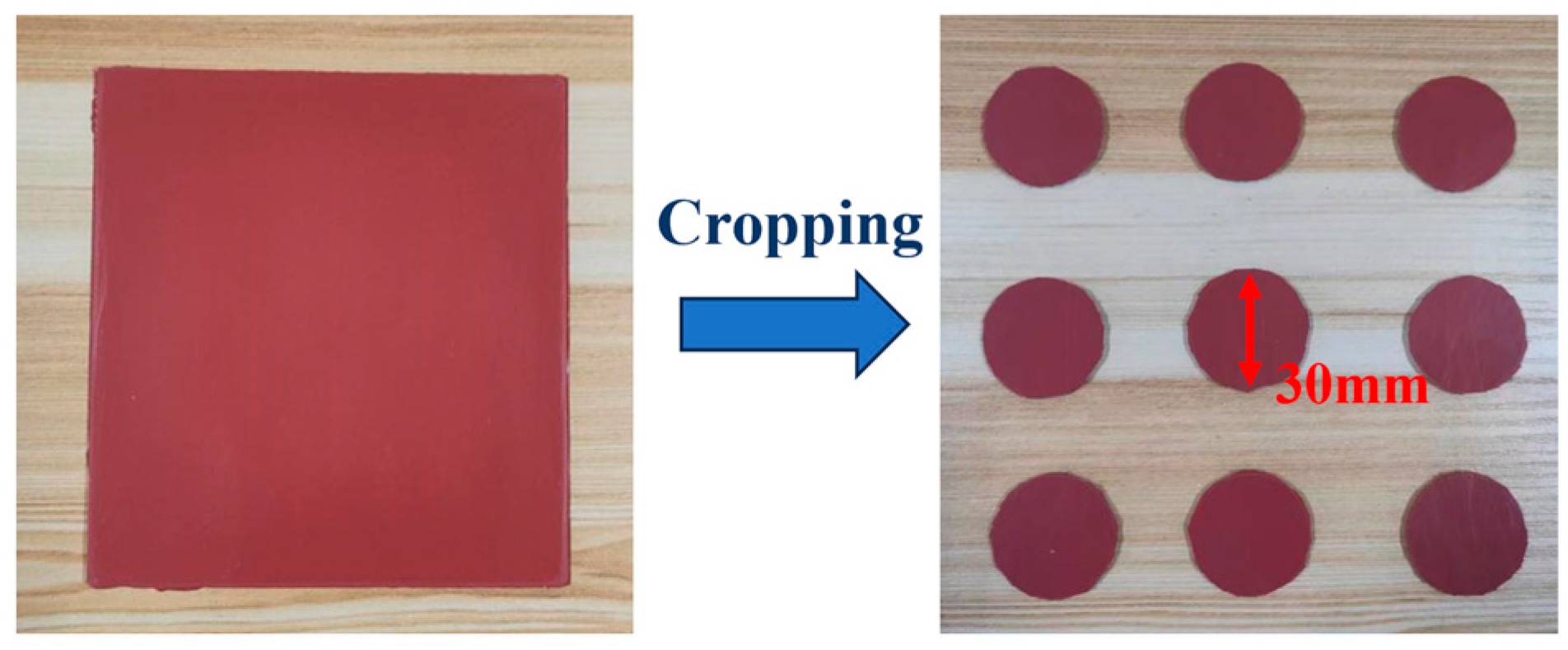
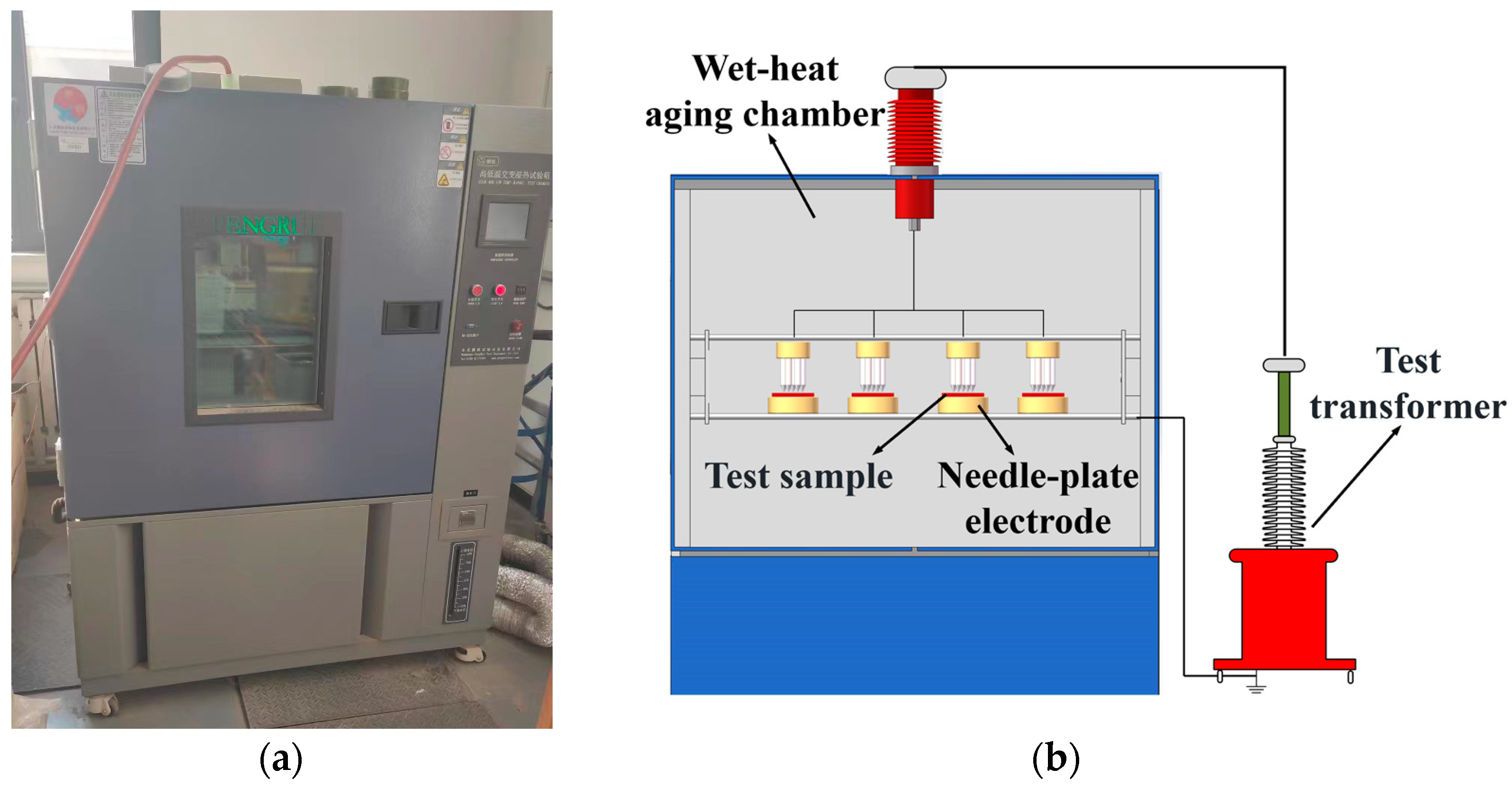
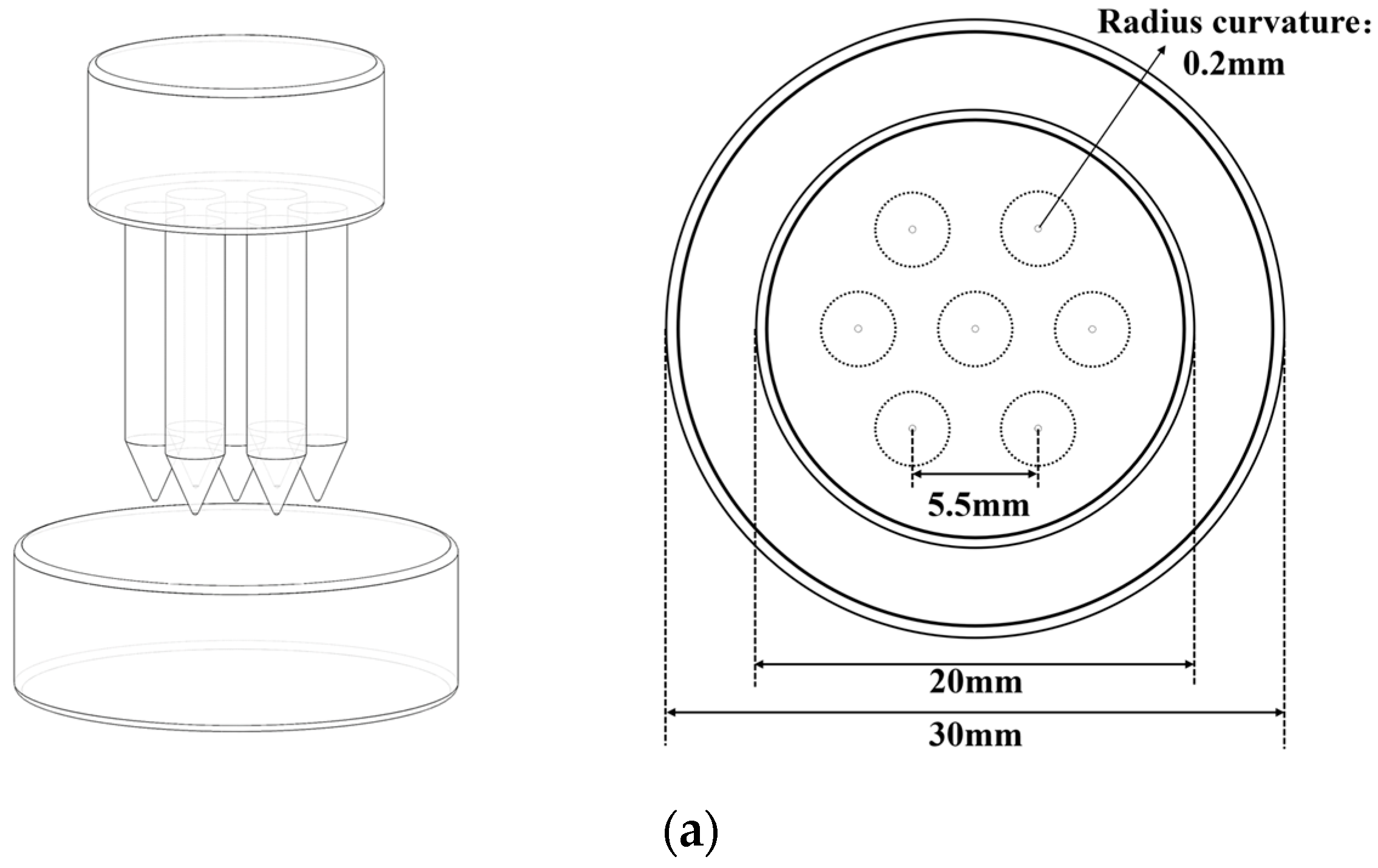
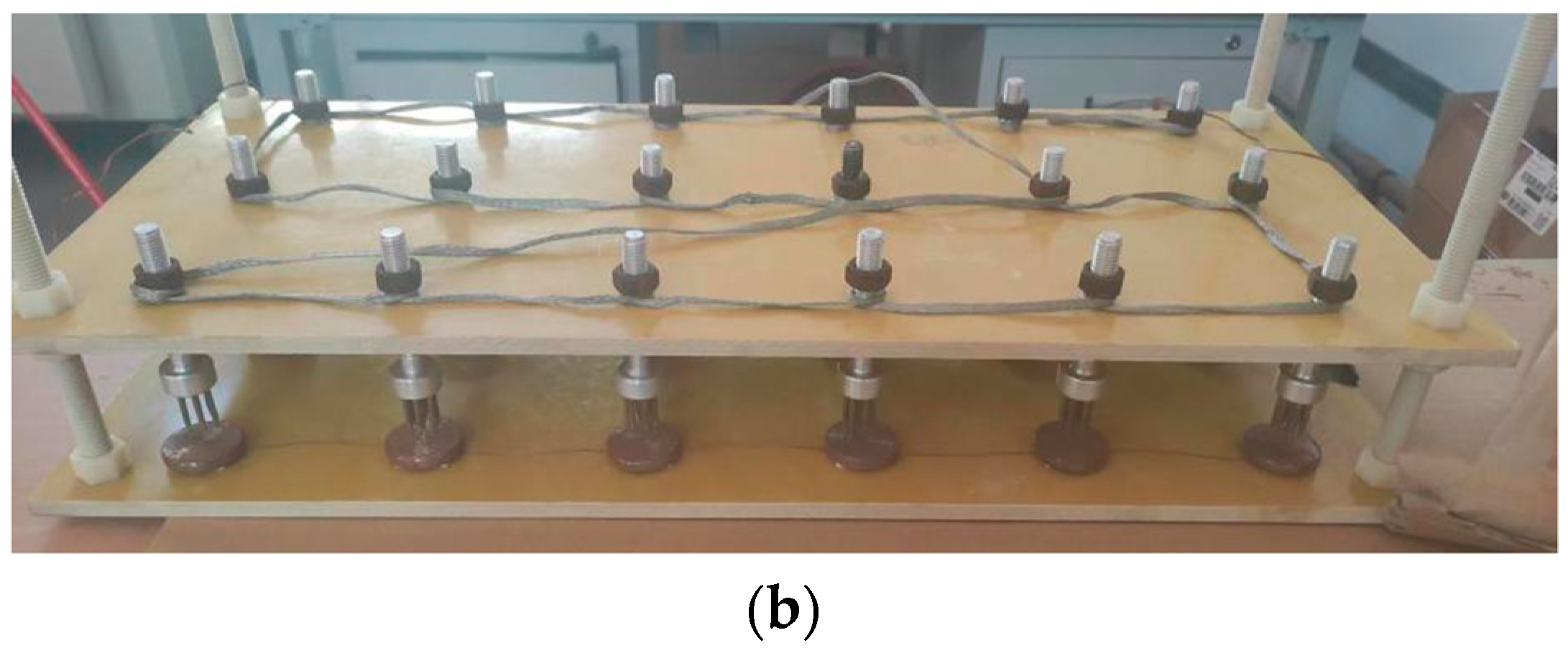
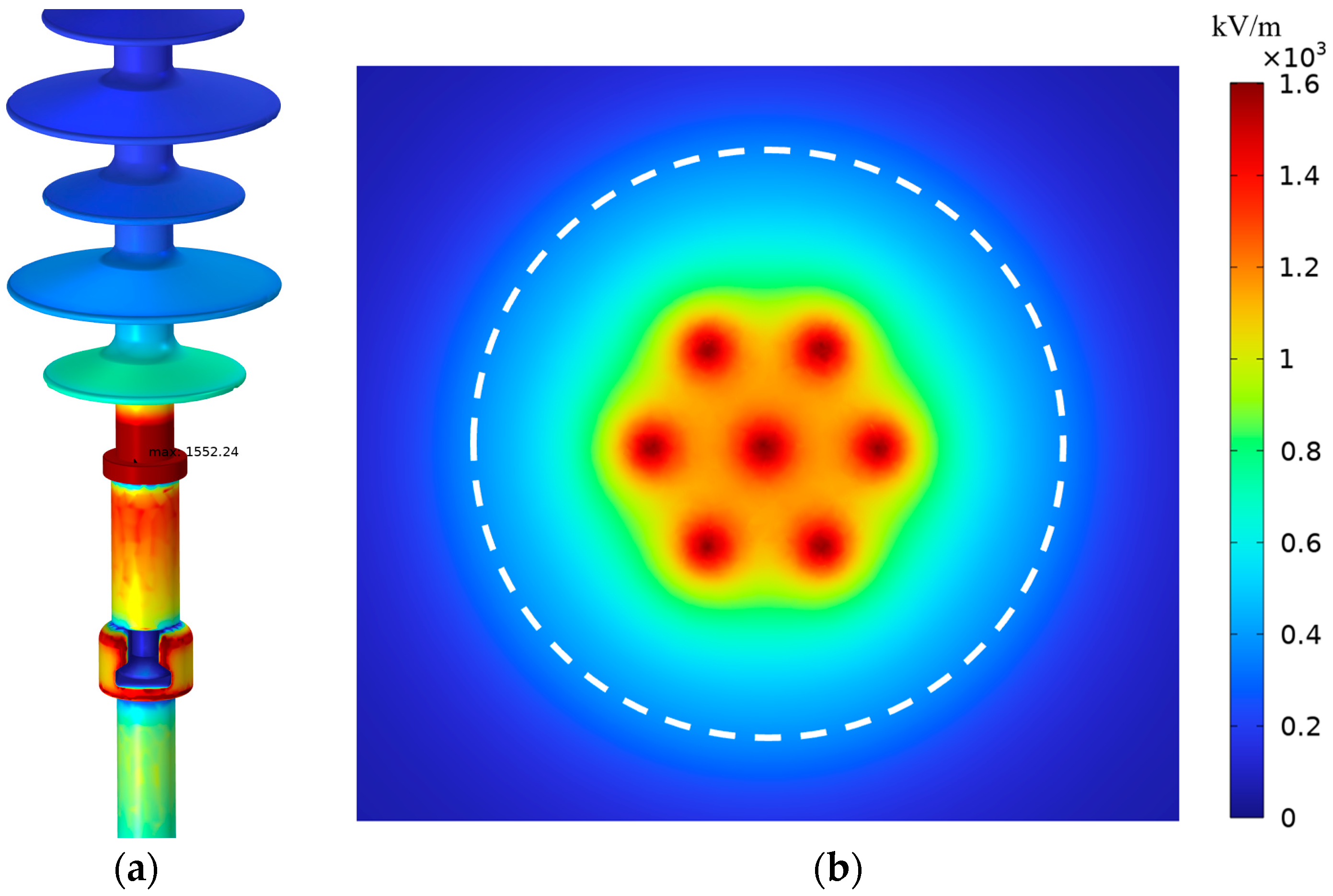

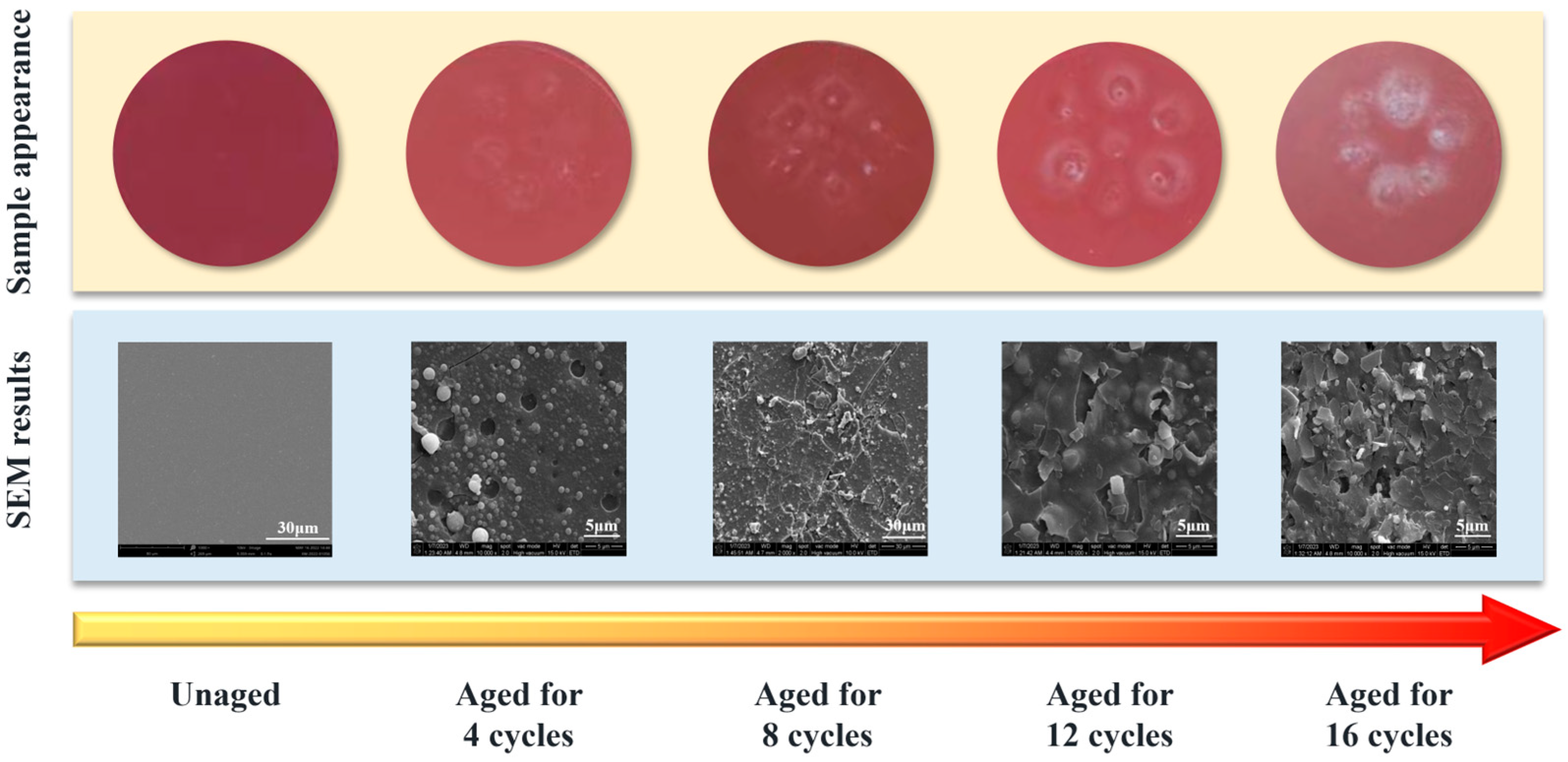

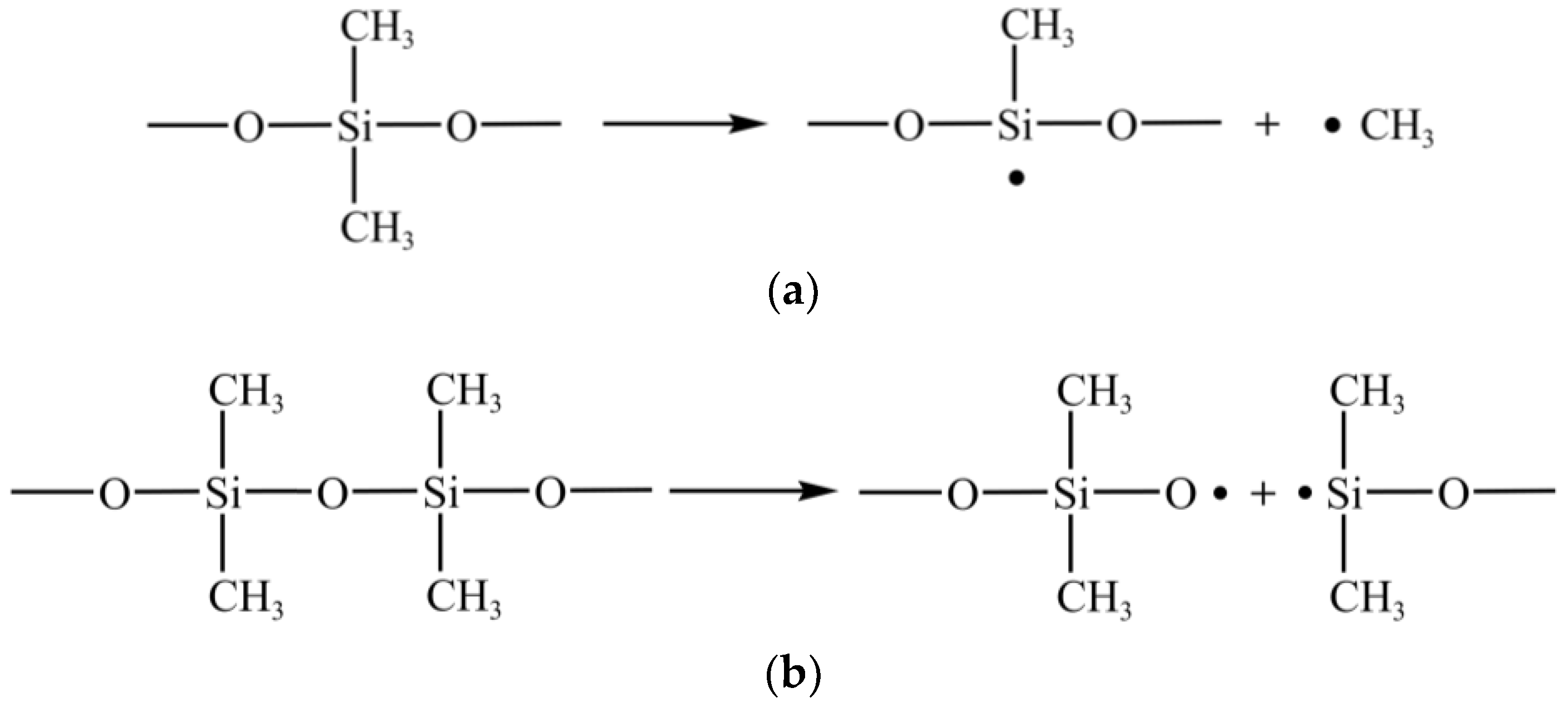
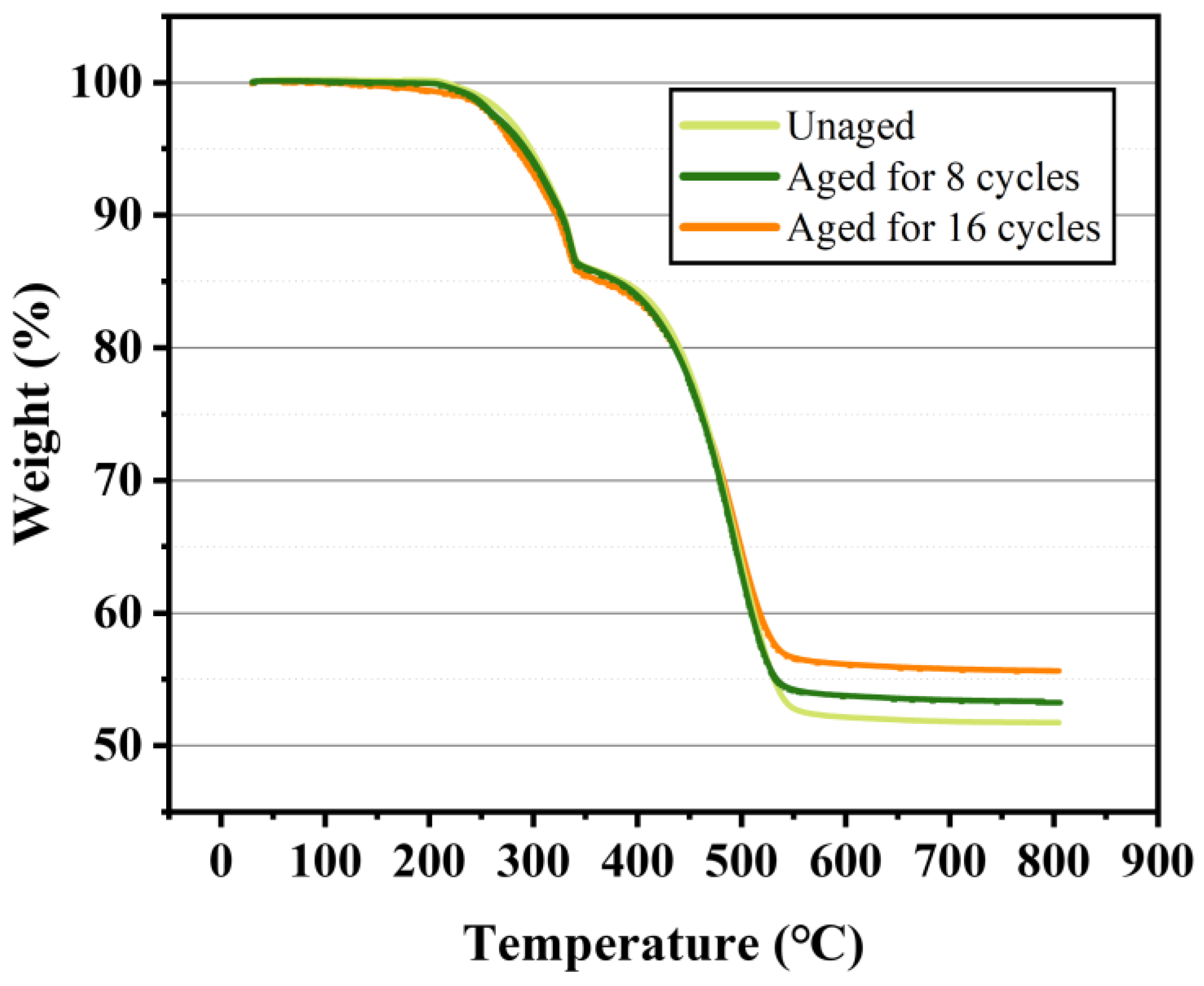

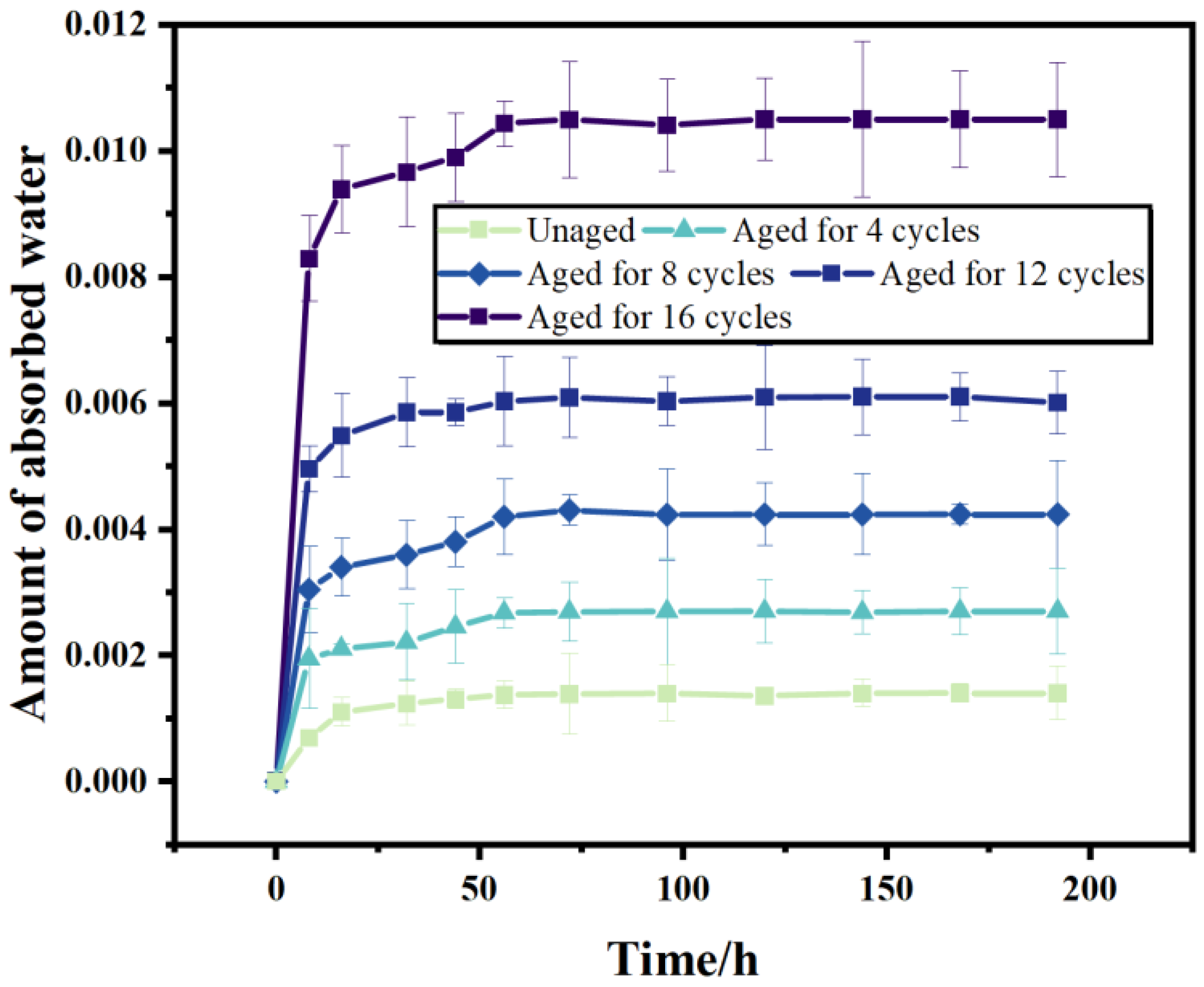
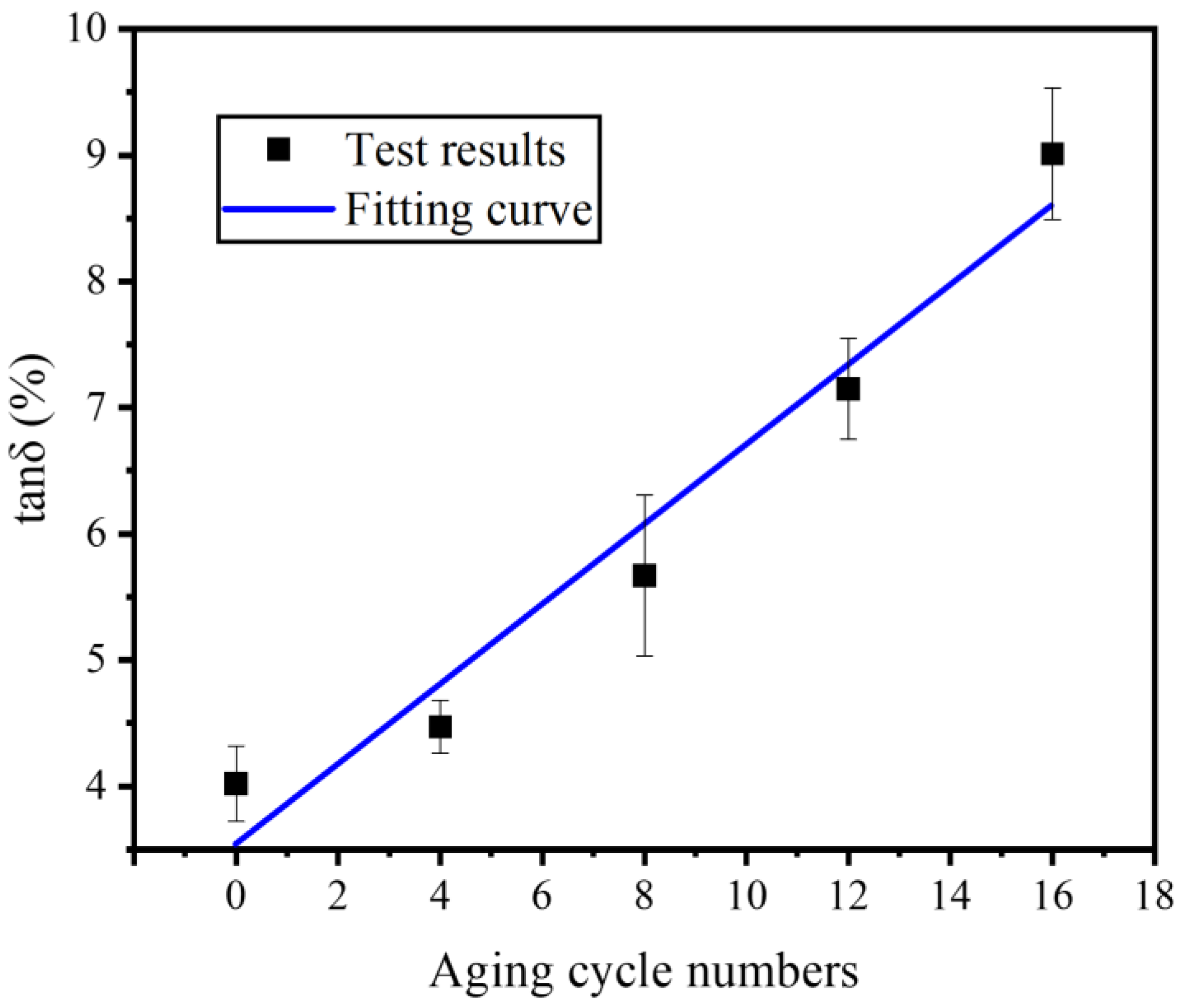
| Compounding Formulation | Silicone Rubber | ATH | SiO2 | Fe2O3 | C10H22 | Hydroxyethyl-Silicone Oil |
|---|---|---|---|---|---|---|
| Mass ratio (phr) | 100 | 80 | 30 | 5 | 3 | 5 |
| Ageing Factor | Condition Parameter | Ageing Stages | |
|---|---|---|---|
| 0~24 h | 25~48 h | ||
| voltage | AC 14 kv | √ | -- |
| humidity | (95 ± 3) % | √ | -- |
| temperature | (40 ± 2) °C | √ | -- |
| salt spray | NaCl: 50.0 kg/m3 | -- | √ |
| Characteristic Functional Group | Wavenumbers/cm−1 | Mode of Vibration |
|---|---|---|
| O–H | 3700–3200 | stretching |
| (C–H) in CH3 | 2960 | stretching |
| (C–H) in Si–CH3 | 1270–1255 | bending |
| (Si–O) in Si–O–Si | 1100–1000 | stretching |
| Si–(CH3)2 | 840–790 | stretching |
| Aging Stages of the Samples | Unaged | Aged for 4 Cycles | Aged for 8 Cycles | Aged for 12 Cycles | Aged for 16 Cycles |
|---|---|---|---|---|---|
| Diffusion coefficient (10−3 cm2/h) | 1.96 | 2.68 | 3.64 | 5.23 | 8.19 |
| Fitting coefficient | 0.991 | 0.969 | 0.972 | 0.967 | 0.983 |
Disclaimer/Publisher’s Note: The statements, opinions and data contained in all publications are solely those of the individual author(s) and contributor(s) and not of MDPI and/or the editor(s). MDPI and/or the editor(s) disclaim responsibility for any injury to people or property resulting from any ideas, methods, instructions or products referred to in the content. |
© 2023 by the authors. Licensee MDPI, Basel, Switzerland. This article is an open access article distributed under the terms and conditions of the Creative Commons Attribution (CC BY) license (https://creativecommons.org/licenses/by/4.0/).
Share and Cite
Li, X.; Zhang, Y.; Chen, L.; Fu, X.; Geng, J.; Liu, Y.; Gong, Y.; Zhang, S. Study on the Ageing Characteristics of Silicone Rubber for Composite Insulators under Multi-Factor Coupling Effects. Coatings 2023, 13, 1668. https://doi.org/10.3390/coatings13101668
Li X, Zhang Y, Chen L, Fu X, Geng J, Liu Y, Gong Y, Zhang S. Study on the Ageing Characteristics of Silicone Rubber for Composite Insulators under Multi-Factor Coupling Effects. Coatings. 2023; 13(10):1668. https://doi.org/10.3390/coatings13101668
Chicago/Turabian StyleLi, Xinran, Yuming Zhang, Lincong Chen, Xiaotao Fu, Jianghai Geng, Yunpeng Liu, Yijing Gong, and Simin Zhang. 2023. "Study on the Ageing Characteristics of Silicone Rubber for Composite Insulators under Multi-Factor Coupling Effects" Coatings 13, no. 10: 1668. https://doi.org/10.3390/coatings13101668
APA StyleLi, X., Zhang, Y., Chen, L., Fu, X., Geng, J., Liu, Y., Gong, Y., & Zhang, S. (2023). Study on the Ageing Characteristics of Silicone Rubber for Composite Insulators under Multi-Factor Coupling Effects. Coatings, 13(10), 1668. https://doi.org/10.3390/coatings13101668







